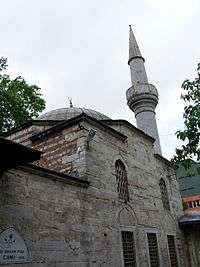Damat Ibrahim Pasha
| Damat Ibrahim Pasha | |
|---|---|
 | |
| Grand Vizier of the Ottoman Empire | |
|
In office 6 January 1599 – 10 July 1601 | |
| Monarch | Mehmed III |
| Preceded by | Cerrah Mehmed Pasha |
| Succeeded by | Yemişçi Hasan Pasha |
|
In office 5 December 1596 – 3 November 1597 | |
| Monarch | Mehmed III |
| Preceded by | Cigalazade Yusuf Sinan Pasha |
| Succeeded by | Hadım Hasan Pasha |
|
In office 4 April 1596 – 27 October 1596 | |
| Monarch | Mehmed III |
| Preceded by | Koca Sinan Pasha |
| Succeeded by | Cigalazade Yusuf Sinan Pasha |
| Ottoman Governor of Egypt | |
|
In office 1583–1585 | |
| Preceded by | Hadım Hasan Pasha |
| Succeeded by | Defterdar Sinan Pasha |
| Personal details | |
| Born |
1517 Croatia or Sanjak of Bosnia, Ottoman Empire |
| Died | 10 July 1601 (aged 84) |
| Spouse(s) | Ayşe Sultan |
Damat Ibrahim Pasha (Turkish: Damat İbrahim Paşa, Bosnian: Damat Ibrahim-paša, Croatian: Damat Ibrahim-paša; 1517–1601) was an Ottoman military commander and statesman who held the office of grand vizier three times (the first time from 4 April to 27 October 1596; the second time from 5 December 1596 to 3 November 1597; and for the third and last time, from 6 January 1599 to 10 July 1601.[1] He is known as the conqueror of Kanije.
He is also called with the title damat ("bridegroom"), because he was a bridegroom to the Ottoman dynasty by marrying Ayşe, one of the sultan's daughters. He is not to be confused with either Pargalı Ibrahim Pasha, illustrious grand vizier of Suleiman the Magnificent, another devşirme and "Damat" to the Ottoman court, or with Nevşehirli Damat Ibrahim Pasha, who held office in early 18th century during the Tulip Era in the Ottoman Empire.
Biography
According to Turkish sources, he was "Bosnian or Croatian"[2] and went through the Devşirme system.[3]
He rose in the ranks during the period when virtual authority and influence was held by Sokollu Mehmed Pasha. In 1581, shortly after Mehmed Pasha's death, Ibrahim Pasha married Ayşe, daughter of the reigning Murad III and became governor of Egypt. But due to his absence from the capital and with Sokollu Mehmed Pasha dead, his influence waned for the rest of the reign of Murad III.
He made a comeback under the reign of Mehmed III, becoming grand vizier in 1596 for the first time. His recall was particularly due to the loss of territories in the border regions between the Ottoman Empire and the Habsburg Monarchy in Hungary. Rather than dashing toward immediate action, he distinguished himself as an orderly, methodical, and prudent statesman who preferred to start by conducting a review of the entire Ottoman administrative system based on the focal point of the prepared campaign against Austria. The campaign as such proved a success and the Ibrahim Pasha acquired the title of "the conqueror of Eger" (north-east of Budapest) for his sultan, although he was the one who held the effective command. Since he favored solidifying the state structure and the gains acquired rather than pursuing Austrians, for which he has been dismissed from the post of grand vizier, at first for a short interval of forty-five days at the end of 1596, and then for a second time at the end of the following year.

He was called back to the grand vizier post in 1599 on the condition that he was to launch a campaign against Austria. He started his campaign by feigning to menace Vienna directly by heading toward Esztergom (conquered by Süleyman the Magnificent in 1543 and lost back in 1595) but finally spent the winter in Belgrade. Then he began to put pressure on Austria through a more southern route by besieging the castle of Kanije. The Turkish slaves in the castle exploded the powder magazines and very badly damaged the walls. But the castle had still not surrendered and an army of 20,000 soldiers commanded by Philippe Emmanuel, Duke of Mercœur arrived to the assistance of the besieged. But the Ottoman Army finally defeated both of the armies and the castle surrendered. Tiryaki Hasan Pasha had been appointed as the governor of the newly conquered city.
Kanije had been transformed into the centre of new Ottoman attacks in Central Europe. In September 1601, an attempt by a huge Austrian army to take back the castle was thwarted by the governor Tiryaki Hasan Pasha. Damat Ibrahim Pasha died the same year. Esztergom was retaken by the Ottoman Empire in 1605.
See also
References
- ↑ İsmail Hâmi Danişmend, Osmanlı Devlet Erkânı, Türkiye Yayınevi, İstanbul, 1971 (Turkish)
- ↑ Necdet Sevinç (1985). Osmanlı sosyal ve ekonomik düzeni. Üçdal Neşriyat.
Damat İbrahim Paşa — Milliyeti : Boşnak yahut Hırvat,
- ↑ Mutlu Dikmen (28 October 2014). BOSNA REHBERİ: BOSNA REHBERİ. Mutlu Dikmen. pp. 11–. GGKEY:BX7UBXRFSNF.
Devşirme sistemiyle Osmanlı hizmetine giren Sırplar ve Hırvatlar arasından da önemli devlet adamları çıkmıştır. Hersekzade Ahmet Paşa, Damat İbrahim Paşa ve Sokullu Mehmet Paşa bunlardan bazılarıdır.
| Political offices | ||
|---|---|---|
| Preceded by Hadım Hasan Pasha |
Ottoman Governor of Egypt 1583–1585 |
Succeeded by Defterdar Sinan Pasha |
| Preceded by Koca Sinan Pasha |
Grand Vizier of the Ottoman Empire 4 April 1596 – 27 October 1596 |
Succeeded by Cigalazade Yusuf Sinan Pasha |
| Preceded by Cigalazade Yusuf Sinan Pasha |
Grand Vizier of the Ottoman Empire 4 December 1596 – 3 November 1597 |
Succeeded by Hadım Hasan Pasha |
| Preceded by Cerrah Mehmed Pasha |
Grand Vizier of the Ottoman Empire 6 January 1599 – 10 July 1601 |
Succeeded by Yemişçi Hasan Pasha |